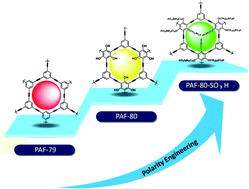Polarity engineering of porous aromatic frameworks for specific water contaminant capture†
Abstract
Recent years have witnessed the rapid development of porous aromatic frameworks (PAFs) for gas adsorption and separation, organic compound uptake and other advanced applications. However, their usages related to water, which is considered as one of the most important natural resources in the world, are still rarely reported. Most of the PAFs are hydrophobic due to their aromatic backbones and there are few research studies about the control of their pore polarity and surface wettability. Herein we use a polarity engineering strategy to design a series of porous aromatic frameworks (PAF-79, PAF-80 and PAF-80-SO3H) with analogous structures but distinct polarity. The resultant PAFs exhibit BET surface areas of about 1964 m2 g−1, 768 m2 g−1 and 200 m2 g−1 respectively. The different functional sites (–OH and –SO3H) laced on the channel walls significantly enhance the surface wettability, which improves the water adsorption capacity from about 150 cm3 g−1 to 194 cm3 g−1 and 226 cm3 g−1, respectively, thereby leading to high affinity towards specific water contaminants. The obtained results mean that the channel's polarity towards water is a predominant factor over surface area. This work gives insights into polarity engineering and surface wettability control for water contaminant capture.



 Please wait while we load your content...
Please wait while we load your content...